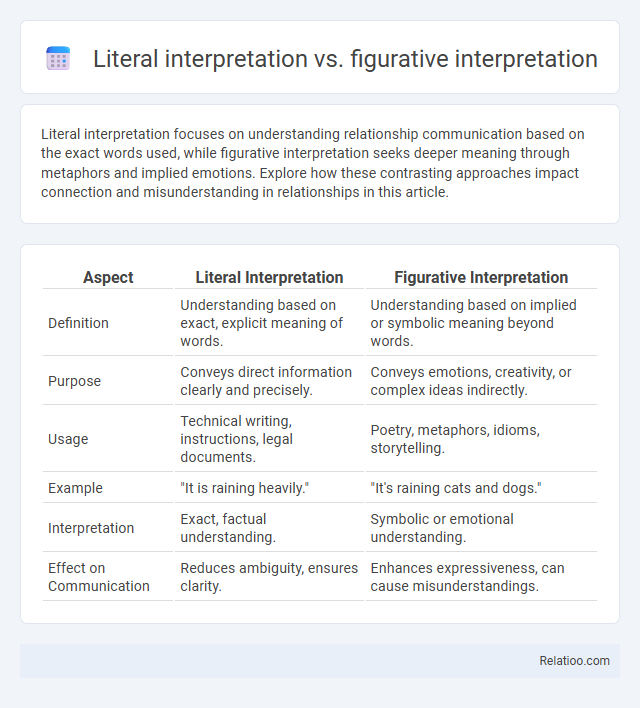Literal interpretation focuses on understanding relationship communication based on the exact words used, while figurative interpretation seeks deeper meaning through metaphors and implied emotions. Explore how these contrasting approaches impact connection and misunderstanding in relationships in this article.
Table of Comparison
| Aspect | Literal Interpretation | Figurative Interpretation |
|---|---|---|
| Definition | Understanding based on exact, explicit meaning of words. | Understanding based on implied or symbolic meaning beyond words. |
| Purpose | Conveys direct information clearly and precisely. | Conveys emotions, creativity, or complex ideas indirectly. |
| Usage | Technical writing, instructions, legal documents. | Poetry, metaphors, idioms, storytelling. |
| Example | "It is raining heavily." | "It's raining cats and dogs." |
| Interpretation | Exact, factual understanding. | Symbolic or emotional understanding. |
| Effect on Communication | Reduces ambiguity, ensures clarity. | Enhances expressiveness, can cause misunderstandings. |
Understanding Literal Interpretation
Literal interpretation involves understanding words and phrases in their most basic, explicit meaning without considering any symbolic or metaphorical nuances. This method prioritizes the direct, concrete sense of language, making it essential for precise communication and legal texts where ambiguity must be minimized. Contrastively, figurative interpretation seeks deeper meanings through metaphors or analogies, while general interpretation encompasses both approaches to derive context-based understanding.
Defining Figurative Interpretation
Figurative interpretation involves understanding language beyond its literal meaning by recognizing symbols, metaphors, and idiomatic expressions that convey deeper or alternative messages. Unlike literal interpretation, which relies strictly on the explicit dictionary definitions of words, figurative interpretation uncovers nuanced insights and emotional resonance embedded in texts. This approach is essential in literature, religious scriptures, and legal documents where context and implied meanings influence comprehension.
Key Differences Between Literal and Figurative Approaches
Literal interpretation relies on the explicit, surface meaning of words, emphasizing exact language and context without deviation. Figurative interpretation explores metaphoric, symbolic, or abstract meanings, uncovering deeper or non-literal insights beyond the text's direct wording. Key differences include the reliance on direct meaning for literal interpretation versus the imaginative or contextual understanding required for figurative interpretation.
Historical Context of Literal and Figurative Interpretations
Literal interpretation emphasizes understanding texts based on the exact wording and historical context, reflecting the original intent of the author or culture at the time of writing. Figurative interpretation considers symbolic, metaphorical, or allegorical meanings often influenced by later cultural, theological, or philosophical perspectives. Historical context is crucial in literal interpretation for accurate comprehension, while figurative interpretation evolves as language and societal views develop over time.
Importance in Religious Texts
Literal interpretation in religious texts emphasizes the exact wording, which ensures a clear and consistent understanding of divine laws and commandments. Figurative interpretation uncovers deeper symbolic meanings, enriching spiritual insight and allowing adaptability across cultural contexts. Both approaches are crucial for comprehensive hermeneutics, balancing doctrinal fidelity with meaningful application in faith communities.
Role in Literary Analysis
Literal interpretation emphasizes the exact meaning of words and phrases in a text, serving as the foundation for understanding the author's explicit message. Figurative interpretation explores symbolic, metaphorical, and imaginative meanings that reveal deeper themes and emotions within a literary work. Your ability to navigate between literal and figurative interpretations enhances critical analysis and enriches comprehension of nuanced narratives in literary studies.
Application in Legal Documents
Literal interpretation in legal documents emphasizes the exact wording, ensuring your contract or statute is understood based on the ordinary meaning of its terms. Figurative interpretation considers context, intent, and broader implications, which often applies when literal meanings lead to ambiguity or unjust outcomes. Interpretation in legal settings balances these approaches to uncover the true purpose of the text, guiding courts and parties in applying laws and agreements effectively.
Common Misconceptions
Literal interpretation refers to understanding text exactly as written without extrapolating hidden meanings, while figurative interpretation seeks symbolic or metaphorical significance beyond the literal words. Common misconceptions include assuming literal interpretation ignores context or that figurative interpretation lacks factual basis, leading to confusion about the text's intended meaning. Interpretation, in general, involves decoding meanings using linguistic, cultural, and contextual cues, balancing both literal and figurative elements for comprehensive comprehension.
Impact on Modern Communication
Literal interpretation ensures clarity and precision in modern communication by conveying messages as explicitly stated, reducing ambiguity. Figurative interpretation enriches conversations with creativity and emotional depth, enabling You to express complex ideas and cultural nuances effectively. Balancing these interpretations enhances understanding, fostering more impactful and engaging exchanges across diverse contexts.
Choosing the Right Interpretation
Choosing the right interpretation depends on the context and purpose of your analysis, distinguishing between literal interpretation, which focuses on the explicit meaning of the text, and figurative interpretation, which explores symbolic or metaphorical meanings. Understanding whether your text requires a straightforward literal analysis or a deeper figurative approach helps ensure accurate comprehension and effective communication. To enhance your analytical skills, consider the author's intent, audience, and the specific language cues present within your material.

Infographic: Literal interpretation vs Figurative interpretation
 relatioo.com
relatioo.com